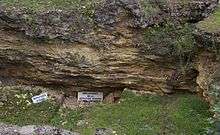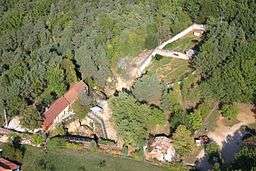Le Regourdou
| Le Regourdou | |
|---|---|
|
|
Le Regourdou[1] (or Le Régourdou)[2] is a Neanderthal archaeological site in the Dordogne department, France. It was a cave before its ceiling collapsed.[3] It is close to the Upper Palaeolithic site of Lascaux.
History
The site of the Regourdou was discovered by chance in 1954 by its owner, Roger Constant. He had seen water being swallowed through a hole into the earth in his farmyard, and chose to enlarge in the hope of discovering the natural entry to the nearby cave of Lascaux. This cave had been discovered in September 1940, shortly after the Battle of France, when a storm uprooted a tree that lay above the entrance, thereby provoking the collapse of part of its vault, opening the current artificial entrance. Constant, having seen a similar collapse in front of his house, considered that there was likely a relationship with the Lascaux cave. He started to dig on his own time without official approval. On 22 September 1957, he discovered a Neanderthal mandible.
Constant immediately contacted François Bordes, director of the Aquitaine prehistoric antiquities.[3] He came with Eugène Bonifay with whom he was working at Laugerie-Haute. Bonifay began excavating at Le Regourdou and discovered what he considered a Neanderthal burial and a brown bear burial. Like all other Neanderthal alleged burials, this has been questioned.[4]
Renewed excavations in 2011 discovered the pelvic remains of Le Regourdou.[5]
Site

Apart from a Neanderthal skeleton discovered in 1957, the excavator of the Regourdou, Eugène Bonifay, found a large number of brown bear bones. These were interpreted as evidence of a "cult of the bear in the Middle Palaeolithic.[6] · [7] This interpretation was seriously questioned given that an occupation of the cave by bears followed by taphonomic phenomena could reasonably be expected to produce what was observed.[8]
Those that claim a burial at the Regourdou have difficulty explaining why it has no head and no lower limbs. The rest of the skeleton is remarkably well preserved. It preserves the mandible, part of the upper limbs, and the sternum. It is often used in Neanderthal comparison studies. It dates to between 70,000 and 50,000 BP.
Shaft cave
The shaft cave is the second site that Roger Constant explored. He started digging there in 1970, a few metres from the main site. He used a crane and wagons to extract dirt from the earth down to a depth of 35 metres. He dug there all his life, hoping to reach the cave of Lascaux.
References
- ↑ J. Piveteau (1959). "Les restes humains de la grotte de Regourdou (Dordogne)". Comptes Rendus de l'Académie des Sciences. D248. Paris. pp. 40–44.
- ↑ "Gisement préhistorique du Régourdou". Culture.gouv.fr. French Ministry of Culture. 11 June 1993. Archived from the original on 30 August 2017. Retrieved 30 August 2017.
- 1 2 "Le Regourdou - one of the most important Neanderthal sites in France". Donsmaps.com. Retrieved 21 October 2017.
- ↑ M. Pelletier; A. Royer; T.W. Holliday; E. Discamps; S. Madelaine; B. Maureille (2017). "Rabbits in the grave! Consequences of bioturbation on the Neanderthal "burial" at Regourdou (Montignac-sur-Vézère, Dordogne)". Journal of Human Evolution. 110. pp. 1–17. doi:10.1016/j.jhevol.2017.04.001.
- ↑ V. Meyer; J. Bruzek; C. Couture; S. Madelaine; B. Maureille (2011). "A new Neanderthal pelvis: morphological description of the Regourdou 1 pelvic remains (Montignac, Dordogne, France)". Paléo. 22. pp. 207–222.
- ↑ Bonifay, E. (1965) - « Un ensemble rituel moustérien à la grotte du Régourdou (Montignac, Dordogne) », in : Actes du IVème Congrès de l'UISPP, Rome, vol. II, pp. 136-140.
- ↑ Pastoureau, M., L'Ours. Histoire d'un roi déchu, Éditions du Seuil, 7 October – ISBN 978-2-02-021542-8.
- ↑ Cavanhié, N. (2007) - Étude archéozoologique et taphonomique des grands carnivores du site paléolithique moyen de Régourdou (Montignac, Dordogne), Université de Toulouse II le Mirail, Mémoire de Master 2.
